11:30 pm Thursday. I’ve just returned from seeing the film Biutiful with Javier Bardem playing a mostly single parent coping with childrearing and working in the multicultural and poor underworld of Barcelona’s exploited immigrant labor. Thanks to the Noyo Theater’s Independent Film Series two nights a week in alternatively-oriented Willits (a town of many hidden gems, I am learning), I still get to see these cutting edge and relatively new films that try our hearts and souls.

I come home humbled. Though I am living in a “construction site,” as Ralph the electrician and solar samurai so aptly named my home at present, I can make myself relatively comfortable. It may take twenty minutes to get a wood fire crackling and warm in the 40 degree mountain night, but soon I can be thoroughly comfortable (and now I’m really good at building a fire!), unlike the Chinese immigrants in the film who sleep huddled in an unheated basement. And I will wake up on the couch in a sleeping bag to a view of the sun streaming over a ridge of redwood and pine trees.
Construction Sight
 In fact, this week the cabin has become a site of wonderful creative chaos, offering me new perspectives on the world of building homes. The cabin walls have been pried apart and cut into for a new sliding glass door (see photo above) and windows. The kitchen sink is now in the yard, leaving me cooking indoors and cleaning up outdoors.
In fact, this week the cabin has become a site of wonderful creative chaos, offering me new perspectives on the world of building homes. The cabin walls have been pried apart and cut into for a new sliding glass door (see photo above) and windows. The kitchen sink is now in the yard, leaving me cooking indoors and cleaning up outdoors.The closet was taken out, opening up the whole space inside and engendering a
 flurry of new plans. Until that blockade came out, I literally couldn't see new possibilities for keeping the space open and improving feng shui. A visit from Nancy the architect (right) stimulated new ideas. Our minds are not open unless we, well, open them somehow!
flurry of new plans. Until that blockade came out, I literally couldn't see new possibilities for keeping the space open and improving feng shui. A visit from Nancy the architect (right) stimulated new ideas. Our minds are not open unless we, well, open them somehow!I still sleep on the tarp covered couch in the cabin, despite a bed set up in the shed, but with the mercury hitting 35 degrees in the night, I prefer the construction site with the woodstove. Even with tarps covering an opened window space in the cabin, a fire provides degree of heat.
Washing my hair in the bucket has gotten a lot easier after I had all my hair cut off. I
 keep adjusting to the more minimal conditions. Letting go of expectations that life should be normal makes the glorified camping a pleasure rather than a source of stress.
keep adjusting to the more minimal conditions. Letting go of expectations that life should be normal makes the glorified camping a pleasure rather than a source of stress.This whole experience makes me ask which of the elemental forces that make our lives comfortable would we least want to do without in our homes? And how does depriving ourselves of them change our relationship to ourselves, each other, the world around us? Which would you most miss? Heat in the cold? Easy light at night? Electricity for gadgets? Hot water for washing? Clean water for drinking? Any water out of a spigot at all? A flush toilet? Cleanliness (as in being surrounded by dirt and inundated with dust)? A comfortable place to sleep?
News of the devastation after the tornadoes in Alabama certainly humbles us as so many there have lost everything, if not their lives.
“How Did You Get Tom Allen to Work on Your Place?”
 With the right contractor, like the locally famous Tom Allen, homebuilding dreams do come true. Whenever I tell anyone that Tom is the contractor, I get a kind of rockstar, adulatory response. Tom normally works on big, custom-built places. Renovating my cabin would normally not be worth his consideration, it seems—except with home building down, he was happy to take up this “interesting” project, as he said.
With the right contractor, like the locally famous Tom Allen, homebuilding dreams do come true. Whenever I tell anyone that Tom is the contractor, I get a kind of rockstar, adulatory response. Tom normally works on big, custom-built places. Renovating my cabin would normally not be worth his consideration, it seems—except with home building down, he was happy to take up this “interesting” project, as he said.Tom (left) is ultra patient, good humored, knowledgeable and skilled, as are his accompanying carpenters—
 actually I want to say Renaissance Men—Mike (right) and Chris (left, below) . Everyday I learn from all of them a slew of information in a realm I have previously little
actually I want to say Renaissance Men—Mike (right) and Chris (left, below) . Everyday I learn from all of them a slew of information in a realm I have previously little  pondered. In fact, at the hardware store, I glanced through a Handyman’s Pocket Handbook and was impressed by the range of knowledge in the book and manifested in what these guys know how to do. Of course, I over analyze everything. What else is a phrigging Ph.D. in the woods gonna do? I look at the amazing skills they have and how ineffective I am in this realm.
pondered. In fact, at the hardware store, I glanced through a Handyman’s Pocket Handbook and was impressed by the range of knowledge in the book and manifested in what these guys know how to do. Of course, I over analyze everything. What else is a phrigging Ph.D. in the woods gonna do? I look at the amazing skills they have and how ineffective I am in this realm.I think about how skills are relative to context.
Tom and Mike spent hours this week digging, surveying and calculating the structure for the foundation walls of the new bathroom (left below). We’re talkin’ a small room here,
 four feet by ten, 40 square feet. But I never appreciated the details involved in such construction, like seeing a flower: jacking up the whole corner of the
four feet by ten, 40 square feet. But I never appreciated the details involved in such construction, like seeing a flower: jacking up the whole corner of the  cabin because it’s sinking (right); building the new foundation to the existing foundation; using the rebar bender to get a very specific form for the rebar that lies in the foundation; tying in the rebar; strapping together the foundation boards; and preparing the trench for the plumber and the pit for the concrete gravel. It’s complicated!
cabin because it’s sinking (right); building the new foundation to the existing foundation; using the rebar bender to get a very specific form for the rebar that lies in the foundation; tying in the rebar; strapping together the foundation boards; and preparing the trench for the plumber and the pit for the concrete gravel. It’s complicated!When people who do remodels tell you that kitchens and bathrooms are the most expensive and complex, now I see why. I have never understood what construction really involves; at least, I’ve never paid attention before, given that I was paying so much attention to my students’ papers and daily lesson plans. My own work revolved aorund the more abstract nature of ideas, producing academic work, nurturing relationships with students and colleagues.
Of course, when we're wrapped up in our own worlds of expertise and experience, we underestimate the trials and triumphs of others. Today, I am in awe of the way carpenters, electricians, plumbers, loggers, millers, and others in the trades can create beauty amd comfort.
I do help out, more on that soon. Here I am at my Denailification Station, r
 emoving nails from pulled out lumber.
emoving nails from pulled out lumber.I’ll return to some of the specific changes in the weeks to come, and how mastery of language provides access to skill expertise, not to mention how new vocabulary is just plain fun, like watching these guys sling around the “vibrator” without even cracking a smile (I repressed my own) or how I got to use the screed and the mag floater. Yeah, you just can’t wait to find out…
But my computer is running out of juice (the 12-volt solar system was disconnected), so I have to shut down for now. Stay tuned.

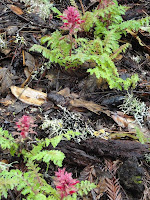 We haven't time, and to see takes time -
We haven't time, and to see takes time - 

 yellow lace, pink clover flower, magenta shooting star, white trillium. (Actually, I don’t know if
yellow lace, pink clover flower, magenta shooting star, white trillium. (Actually, I don’t know if 
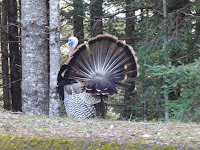




 First, what are these renovations I keep talking about? Principally, I’m getting an indoor bathroom added onto the cabin, incorporating the current composting toilet.
First, what are these renovations I keep talking about? Principally, I’m getting an indoor bathroom added onto the cabin, incorporating the current composting toilet. 




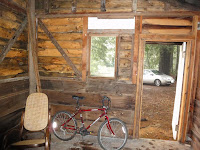




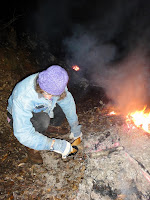










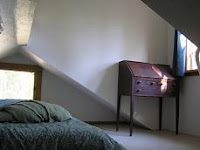


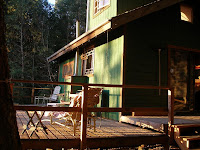

 The green tub has a mixture of soil, lime or ash and sawdust. After you use the toilet, you throw in 2-3 cupfuls of the mixture, which not only reduces the smell but helps compost the human manure. You see two toilets: one is composting for a year while the other is in use. By the time the "in-use" toilet is full, the other has become an odorless pile of nutrient rich composted soil. Really! It works! And no water wasted.
The green tub has a mixture of soil, lime or ash and sawdust. After you use the toilet, you throw in 2-3 cupfuls of the mixture, which not only reduces the smell but helps compost the human manure. You see two toilets: one is composting for a year while the other is in use. By the time the "in-use" toilet is full, the other has become an odorless pile of nutrient rich composted soil. Really! It works! And no water wasted. 